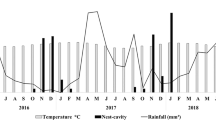Abstract
This study aimed to test the feasibility and effectiveness of introducing trap nests inhabited by the oil-collecting bee Centris (Heterocentris) analis on increasing productivity of organic orchards of acerola (Malpighia emarginata). Trap nest blocks containing 242 nests of C. analis were placed on the border of 22 orchards of four acerola varieties and monitored over the blooming season. Results were compared to other 22 orchards without bee introduction and showed an increment of 62 % in the number of trap nests inhabited by C. analis and acerola yield was significantly higher in the orchards where bees were introduced, independently of variety. The increase in productivity was 1,798 kg/ha. It was concluded that the introduction of inhabited nests of C. analis to acerola orchards allows multiplying populations of C. analis; to increase the number of bees and to reduce pollination deficits in acerola orchards; and can provide real gains in productivity of acerola commercial plantations.
Similar content being viewed by others
References
Cane, J.H. (2001) Habitat fragmentation and native bees: a premature verdict? Conserv. Ecol. 5(1), 3
Free, J.B. (1993) Insect pollination of crops, p. 684p. Cardiff University Press, London
Freitas, B.M., Alves, J.E., Brandão, G.F., Araujo, Z.B. (1999) Pollination requirements of West Indian cherry (Malpighia emarginata) and its putative pollinators, Centris bees, in NE Brazil. J. Agr. Sci 133, 303–311
Freitas, B.M., Imperatriz-Fonseca, V.L., Medina, L.M., Kleinert, A.M.P., Galetto, L., Nates-Parra, G., Quezada-Euán, J.J.G. (2009) Diversity, threats and conservation of native bees in the Neotropics. Apidologie 40(3), 332–346
Guedes, R.S., Zanella, F.C.V., Martins, C.F., Schlindwein, C. (2011) Déficit de polinização da aceroleira no período seco no semiárido paraibano. Rev. Bras. Frutic. 33(2), 465–471
Oliveira, R., Schlindwein, C. (2009) Searching for a manageable pollinator for Acerola orchards: the solitary oil-collecting bee Centris analis (Hymenoptera: Apidae: Centridini). J. Econ. Entomol. 102(1), 265–273
Roubik, D.W. (1992) Ecology and natural history of tropical bees. Cambridge University Press, Cambridge. 514p
Vaissière B.E., Freitas B.M.; Gemmill-Herren B. 2011. Protocol to detect and assess pollination deficits in crops: a handbook for its use, Rome: FAO, 81 p
Vicens, N., Bosch, J. (2000) Pollinating efficiency of Osmia cornuta and Apis mellifera (Hymenoptera: Megachilidae, Apidae) on ´Red Delicious´apple. Popul. Ecol. 29, 235–240
Vilhena, A.M.G.F., Rabelo, L.S., Bastos, E.M.A.F., Augusto, S.C. (2012) Acerola pollinators in the savanna of Central Brazil: temporal variations in oil-collecting bee richness and a mutualistic network. Apidologie 43(1), 51–62
Acknowledgments
Authors thank Dr. Fernando Zanella for identification of the Centridini bees; Amway Nutrilite do Brasil for permission to carry out this study in its farm; two anonymous referees for their substantial contribution to this paper and National Council for Scientific and Technological Development-CNPq, Brasília-Brazil for the M.Sc. scholarship to C. B. Magalhães and the research fellowship to B.M. Freitas (proc. #302934/2010-3).
Augmentation de la récolte de fruits dans les vergers d’acerola ( Malpighia emarginata ) grâce à l’introduction de nids artificiels pour l’abeille récolteuse d’huile, Centris analis (Hymenoptera: Apidae: Centridini)
Élevage d’abeilles / pollinisation des cultures / déficit en pollinisation / abeilles solitaires/ nid-piège
Die Einführung von nestern der ölsammelnden Biene Centris analis (Hymenoptera: Apidae: Centridini) zur Bestäubung erhöht den Ertrag von Acerola-Kirschen ( Malpighia emarginata )
Bienenaufzucht / Bestäubung / Bestäubungsdefizit / Sölitärbienen / Nisthilfen
Author information
Authors and Affiliations
Corresponding author
Additional information
Manuscript editor: Stan Schneider
Electronic supplementary material
Below is the link to the electronic supplementary material.
ESM 1
DOC 801 kb
Rights and permissions
About this article
Cite this article
Magalhães, C.B., Freitas, B.M. Introducing nests of the oil-collecting bee Centris analis (Hymenoptera: Apidae: Centridini) for pollination of acerola (Malpighia emarginata) increases yield. Apidologie 44, 234–239 (2013). https://doi.org/10.1007/s13592-012-0175-4
Received:
Revised:
Accepted:
Published:
Issue Date:
DOI: https://doi.org/10.1007/s13592-012-0175-4




